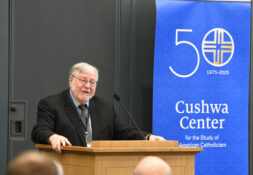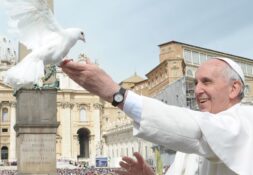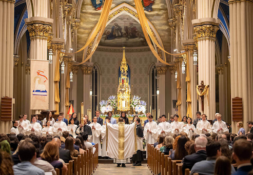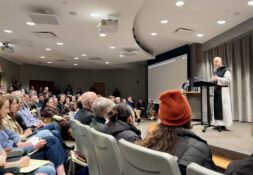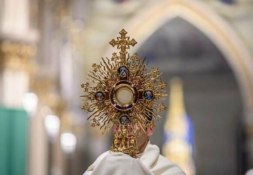In 2011, Pope Benedict XVI’s Apostolic Letter Porta Fidei called for a Year of Faith to coincide with the 50th anniversary of the Second Vatican Council and the 20th anniversary of the Catechism of the Catholic Church. It will begin on 11 October 2012, and it will end on the Solemnity of Christ the King, 24 November 2013.
His Holiness Pope Benedict XVI calls for the Church to “rediscover a taste for feeding ourselves on the word of God, faithfully handed down by the Church, and on the bread of life, offered as sustenance for his disciples.” In order to do this, the Pope asks that the Church reflect on both the documents of the Second Vatican Council, as well as gain greater familiarly with the Catechism of the Catholic Church, which he believes is a valuable source to further ground oneself in doctrine.
This is not the first time a Year of Faith has been invoked: in 1967, Pope Paul VI called for one on the occasion of the 19th centenary of Saints Peter and Paul’s martyrdom, urging the Church to make “an authentic and sincere profession of the same faith.”
Pope Benedict invites the Church to make a similar renewal of the faith “so as to shed ever clearer light on the joy and renewed enthusiasm of the encounter with Christ.” As seen with the Pope’s Jesus of Nazareth series and as personally expressed by him, Pope Benedict consistently has invited and encouraged all people to develop a closer and more personal relationship with Jesus Christ.
In developing a closer relationship with Christ and his Church, the Year of Faith wants “to arouse in every believer the aspiration to profess [emphasis original] the faith in fullness and with renewed conviction, with confidence and hope.” Benedict goes on to teach that it is not sufficient to have knowledge of the faith, but to also be able to accept it in one’s heart, “the authentic sacred place within one person,” which is opened by the grace of God.
With God’s grace, one uses his intellect and will to become formed in the teachings of the Christ handed down by Christ through his Church and this knowledge, in turn, becomes important for one’s assent to the faith as propose by the Church. Thus, Benedict said that the “Year of Faith will have to see a concerted effort to rediscover and study the fundamental content of the faith” seen in the systematized Catechism of the Catholic Church and in the Vatican II documents.
In continuity with past successors to the Holy See who emphasized a need for a proper understanding of the decrees of the Second Vatican Council, Pope Benedict quoted Blessed John Paul II on the documents of Vatican II: “They need to be read correctly, to be widely known and taken to heart as important and normative texts of the Magisterium, within the Church’s Tradition….”
In the mission of the Church to share the love for Christ in every age, the Pope recognizes “a need for stronger ecclesial commitment to new evangelization in order to rediscover the joy of believing and the enthusiasm for communicating the faith.”
From this, the “new evangelization” has become a strong and central subject in Benedict’s Year of Faith. The theme for this year’s General Assembly of the Synod of Bishops that will convene this October is “The New Evangelization for the Transmission of the Christian Faith.”
So far, the Holy See has reached out to the Church through its extensive website for the Year of Faith, www.annusfidei.va. The website is run by the Pontifical Council for Promoting the New Evangelization and can be read in Italian, English, or Spanish.
The Catechism, Compendium to the Catechism, and the documents from the Second Vatican Council are easily accessible from the website. Various homilies and videos of the Holy Father’s Wednesday Audiences on themes such as the Church Fathers, Women of Faith, and Christian Prayer, as well as a calendar of events that includes the canonization of seven new saints, including two from North America: Blesseds Kateri Tekakwitha and Marianne Cope.
Each page is connected to social networking and social media sites such as Facebook, Twitter, GooglePlus, YouTube, and Flickr, encouraging sharing of events throughout the web.
Recommendations for the Year of Faith was given by the prefect and secretary of the Congregation for the Doctrine of the Faith (CDF). For the universal church, the CDF encourages pilgrimages to the Sea of Peter, to the Holy Land, and to major Marian Shrines.
In terms of Marian devotion, William Cardinal Levada, prefect of the CDF, expressed that “every initiative that helps the faithful to recognize the special role of Mary in the mystery of salvation, love her and follow her as a model of faith and virtue is to be encouraged,” for she is the “model of the Church.”
In regards to planned ecumenical initiatives, Cardinal Levada has stressed the importance of unity among all Christians and stated that “there will be solemn ecumenical celebration in which all of the baptized will reaffirm their faith in Christ.”
In each level of the Church, the CDF emphasizes stronger catechetical programs where proper teaching of the faith is upheld and strengthened in seminaries, religious communities and associations, parishes, and schools. A closer study should also be made of the documents of Vatican II. Such renewal must take place in all states of life, among the clergy, religious, and lay.
In the end, Pope Benedict reminds the Church to return to Christ and to be able to share the Truth of Christ: “Christians are called to radiate the word of truth that the Lord Jesus has left us…The Year of Faith, from this perspective, is a summons to an authentic and renewed conversion to the Lord, the one Saviour of the world.”
Sandra Laguerta is a senior theology major, proud to have heard Prof. Ralph Wood’s shout-out to the Little Sisters of the Poor in his lecture on Tolkien, hosted by the Center of Ethics and Culture. She encourages you to watch the lecture on the Center’s website and to contact her at slaguert@nd.edu.
